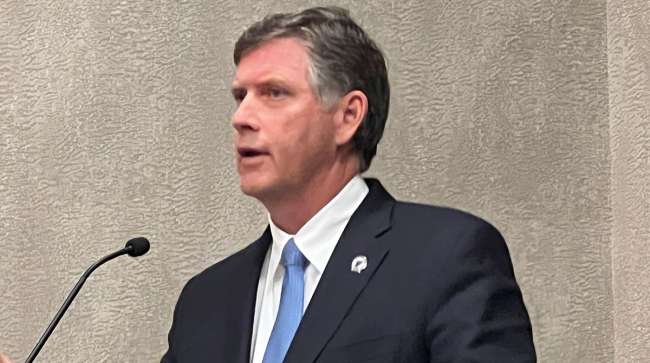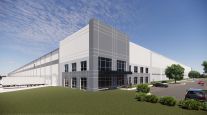Senior Reporter
Port Leaders See Viability of Inland Facilities

[Stay on top of transportation news: Get TTNews in your inbox.]
AURORA, Colo. — As land around the nation’s congested seaports gets more expensive and those facilities increasingly find themselves landlocked, port leaders said a viable option is to develop inland ports.
By moving more cargo from the water and taking it inland, they asserted, freight movement could be made more efficient and possibly less expensive long term.
That was the conclusion that was reached during a panel of transportation leaders at the American Association of Port Authorities annual convention, where Georgia Ports Authority Executive Director Griff Lynch pointed to decisions by government officials to expand the Port of Savannah with two inland ports, linked by two Class I railroads, hundreds of miles from the complex on the Savannah River.
“One of the things we learned in the pandemic, and that surge and slowdown of cargo, is that no terminal is big enough to support a major disruption — and the main way to break through that disruption is to have additional land,” Lynch told Transport Topics.
Cary Davis, AAPA President & CEO, on the value of this week:
“We’re here to learn, grow, get smart and energized. We’re here to rally around a vision and a compelling message that answers the question of why anyone, but really why everyone, should care about ports.” #AAPAEXPO pic.twitter.com/a2PeTOgskx — AAPA (@AAPA_Seaports) October 24, 2023
Georgia has been particularly aggressive with opening inland ports. In the summer of 2018, officials began moving cargo from Savannah to the Appalachian Regional Port near the Tennessee border via a 388-mile, CSX-operated rail line.
Now officials are developing and plan to open in 2026 the 104-acre, Northeast Georgia Inland Port in Gainesville, 50 miles outside Atlanta. The $170 million facility will be connected to Savannah with a 324-mile, Norfolk Southern rail line.
Farm and construction equipment producer Kubota Manufacturing will be the port’s anchor customer, as its plant is adjacent to the new port. Gainesville, Ga., also is one of the nation’s leading cities for poultry processing, and it’s expected that poultry will be the principal product shipped to Savannah for export.

Chewning
Panel members said that for inland ports to be successful, the new facilities need to be fully wired for electric vehicles and other port equipment as well as having contingencies ready for alternative fuels for trucks.
“In smaller inland ports, you can take a gamble with new technology,” said Scott Chewning, a project manager with Burns & McDonnell Global Facilities Group. “It hasn’t always been perfect. But at one facility, we went fully electric with rubber-tired gantry cranes, and it was the first time we did that.”
Chewning said that at the Northeast Georgia Inland Port, the decision has been made to install 20 hybrid rubber-tired gantries because of better pricing and because they use less diesel fuel and are less polluting than traditional diesel cranes.

Sabatini
The officials also stressed that these facilities must have freight rail connections to the main port because they believe at longer distances, especially, trains are more competitive than trucks. One train can move the equivalent of hundreds of trucks, at a lower cost and with less pollution.
“Whether it’s us, at OmniTrax, or whatever rail company you’re dealing with, these smaller companies that are serving the ports ... want to invest in your business,” OmniTrax President and Chief Operating Officer Sergio Sabatini said. “They’re the ones that want to invest in your business. It’s not often the Class I railroads are going to lay out $10 million, $20 million, $100 million to invest in your business.”
Denver-based OmniTrax manages more than two dozen short-line railroads and real estate in the U.S. and Canada.

Hecker
PortMiami also is far along in its plans to develop an inland port on a 415-acre parcel of land that is a decommissioned airport in West Opa-locka in northwest Miami-Dade County.
“Our port is 520 acres and handles more than 1 million containers a year, and we can grow at that location now another 25% or 30%. But we’re landlocked, and if we’re going to expand beyond that, we are going to need another location,” Andy Hecker, PortMiami chief of strategic management, told Transport Topics. He added that as more companies nearshore their manufacturing facilities to North America from China, the ports must have the capacity to handle the expected increase in goods from Mexico and other nations in the second half of this decade and the 2030s.
Volvo's Keith Brandis and Eric Bond take an in-depth look at how the company's SuperTruck 2 improves freight efficiency. Tune in above or by going to RoadSigns.ttnews.com.
“When you look to the future, there is not enough truck power to support the growth of the ports. The trucking industry is short 80,000 drivers today,” GPA’s Lynch said. “Long term, we need to have alternatives for our customers. For longhaul, we believe rail is the way to go, but for short and medium haul, it’s truck.”
The transportation leaders also pointed to Utah Inland Port Authority, currently under development, as the model many facilities will use in the future. Plans call for a 16,000-acre dry port that would take freight from the Port of Long Beach and Port of Oakland and move that cargo by rail more than 800 miles inland and then by truck to its eventual location. Similar projects are on the drawing board in the Dallas area with a 7,500-acre facility, eventually connected to the ports of Los Angeles and Long Beach by rail and with direct access to three major interstates, I-35, I-45 and I-20.
Want more news? Listen to today's daily briefing below or go here for more info:





